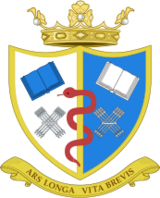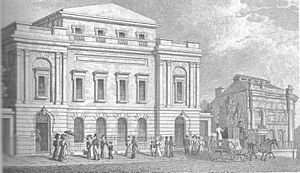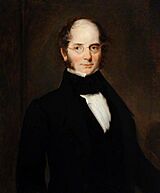Sheffield Medical School facts for kids

|
|
| Motto | Latin: Ars longa vita brevis |
|---|---|
|
Motto in English
|
Art is long, life is short |
| Type | Medical school |
| Established | 1828 – Sheffield School of Practical Anatomy and Medicine |
|
Parent institution
|
University of Sheffield |
| Dean | Chris Newman |
| Head of Faculty | Ashley Blom |
| Students | over 2,000 |
| Location |
,
,
England
|
The University of Sheffield Medical School is a special school at the University of Sheffield in Sheffield, England. It teaches students to become doctors. The school has been around since at least 1828.
It used to be a separate school. But in 1897, it joined with Firth College and Sheffield Technical School. Now, it's a big part of Sheffield's Faculty of Medicine, Dentistry and Health.
The Medical School has four main departments. These departments teach, do research, and practice medicine. In 2020, the school was ranked 12th in the UK for health studies. Each year, about 273 UK students and 18 international students join its five-year medical program.
Contents
History of the Medical School
How it Started
Medical teaching in Sheffield began early, around 1811, with a surgeon named Hall Overend. Back then, doctors learned through apprenticeships. But a new law in 1815 changed things. It made the Society of Apothecaries in London in charge of medical training.
Hall Overend started his own school, the Sheffield School of Practical Anatomy and Medicine. This became the oldest higher education place in Sheffield. It was also one of the first medical schools outside London. In 1828, the school's teachers were officially recognized. Overend taught about the human body and chemistry. He also showed dissections at his home.
Later, doctors from the Sheffield Royal Infirmary (the city's first hospital) thought a medical school linked to a hospital would be better. In 1828, Arnold James Knight, a doctor at the infirmary, suggested starting a public medical school. Hall Overend supported this idea. His son, Wilson Overend, took over his father's school in 1829. But his school later burned down in 1835.
Becoming an Independent School
The new public medical school, called the Sheffield Medical Institution, opened on July 2, 1829. Arnold Knight helped start it. He gave a speech about how students would learn medicine. This school was owned by a group of people. It had a lecture room, a dissection room, and a library.
The teachers were doctors from local hospitals. The school changed its name a few times. In 1865, it became Sheffield Medical School, and in 1868, the Sheffield School of Medicine. It worked with the Sheffield Children's Hospital and Jessop Hospital for Women to teach medical students.
The school faced tough times and almost closed twice. This was because teachers left, and it was hard to find new ones. Also, the school competed for money with other hospitals.
In 1879, Firth College helped save the medical school. Firth College started teaching science subjects to medical students. This made the two schools work closely together. In 1888, the medical school moved to a new building on Leopold Street, across from Firth College. The new building had classrooms, a lecture hall, a dissection room, a library, and a museum.
By the late 1800s, the head of Firth College wanted to create a university in Sheffield. So, in 1897, the medical school, Firth College, and the Sheffield Technical School joined together. They formed the University College of Sheffield. The medical school became one of its departments.
The Medical School at the University
In 1905, the University College of Sheffield officially became the University of Sheffield. Medicine was one of the first main subjects taught at the new university. The Medical School moved to a new part of the Firth Court building. In 1909, Lydia Manley Henry was one of the first female students to join the Medical School. She became a doctor in 1916.
In 1973, the Medical School moved to its current building on Beech Hill Road. This building is right next to the Royal Hallamshire Hospital. Hall Overend is now seen as the founder of medical education in Sheffield. The school changed its name a few times. In 2011, it went back to being called the Medical School.
Departments
Academic Unit of Medical Education
This department focuses on teaching future doctors. It has:
- The Clinical Skills Centre: Here, students practice healthcare skills in special rooms that look like hospital wards. They learn how to help patients and even practice emergency care. It's located at the Northern General Hospital.
- The Medical Teaching Unit (MTU): This unit has teaching rooms, many examples of body parts for study, and a special lab that preserves human body parts for long-term learning. It's on the Western Bank Campus.
- The Academic Unit of Primary Medical Care: This part teaches students about general practice and family doctors. It also does research in this area.
Postgraduate and Research Departments
The Medical School offers advanced degrees for students who want to study medicine even more. These programs are available through three departments:
- The Department of Infection, Immunity and Cardiovascular Disease: This group researches how our bodies fight off sickness, how our hearts and blood vessels work, and how to use imaging to see inside the body.
- The Department of Neuroscience: This department studies brain diseases like motor neuron disease, Parkinson's disease, and Alzheimer's disease.
- The Department of Oncology and Metabolism: This group focuses on teaching and research about cancer, hormones, and how the body grows and reproduces.
Campus and Facilities
The Sheffield Medical School building is on Beech Hill Road, right next to the Royal Hallamshire Hospital. It has three large lecture halls and eight smaller rooms for group meetings. The building also holds the Sheffield Biorepository, which stores human tissues for research.
Another part of the school is at the Northern General Hospital. This is where the Clinical Skills Centre and the Academic Unit of Primary Medical Care are located. It has rooms that look like hospital wards for practice.
Libraries
The school has two libraries called the Health Sciences Library.
- One library opened at the Royal Hallamshire Hospital in 1978. It has books and resources about medicine, dentistry, and nursing.
- The other library is at the Northern General Hospital. It also has materials for medicine and nursing students.
Hospitals the School Works With
The Sheffield Medical School works closely with several local hospitals. Students get to learn and practice in these hospitals:
The school also works with hospitals in other nearby towns like Rotherham, Doncaster, Bassetlaw, and Barnsley.
Academics
Teaching Future Doctors
The main medical course is a five-year program. Students earn an MBChB degree, which means they become doctors. The course has four main parts:
- Phase 1 (First Year): Students learn about how the human body is built and how it works.
- Phase 2a (Second Year): Students work on a research project and practice basic medical skills.
- Phase 2b (First Half of Third Year): Students learn basic clinical skills and spend time in one of Sheffield's teaching hospitals.
- Phase 3 (Second Half of Third Year and Fourth Year): This phase is mostly about learning in real hospital settings.
- Phase 4 (Final Year): Students attend lectures and spend time in different hospitals and medical areas.
There's also a four-year program for students who already have a science degree. They skip the first year of the regular program.
Medical Research
The Medical School has 18 different research areas. Some of these include:
- Studying bones and joints.
- Researching cancer.
- Looking into heart and blood vessel diseases.
- Studying brain diseases like dementia and Parkinson's disease.
- Researching how our bodies fight off infections.
- Learning about human reproduction.
The school has been part of some very important medical discoveries:
- In the 1920s, Edward Mellanby found that cod liver oil could prevent rickets, a bone disease. This discovery helped get rid of rickets.
- In the 1930s, Cecil Payne was one of the first to use Penicillin to cure someone.
- Also in the 1930s, Sir Hans Krebs made big discoveries about how cells get energy. He described this process in the Krebs Cycle, and he won a Nobel Prize for his work in 1953.
Motto and Coat of Arms
The motto of the Sheffield Medical School is Ars longa vita brevis. This is Latin for "Art is long, life is short." It means that learning and practicing medicine is hard and takes a long time, but life is short. This motto comes from an old saying by the Greek doctor Hippocrates.
A stone carving with this motto was on the old medical school building from 1829. When that building was taken down in 1965, the stone was saved. Now, you can see it near the entrance of the current medical school building.
The school also has its own Coat of arms. It was given to the school in 2003. It has parts from the University of Sheffield's coat of arms, like a crown and open books. It also has the rod of Asclepius, which is a symbol for medicine. You can see this symbol around the Medical School buildings.
Student Life
The Sheffield Medical Society (MedSoc) is the biggest student group at the University of Sheffield Students' Union. It represents over 2,000 medical students. MedSoc has 33 smaller groups for different interests, like academic clubs and sports teams.
Notable Alumni and Staff
-
British Army medical officer William Barnsley Allen (MBChB, 1914)
-
Christopher Addison, first Arthur Jackson Professor of Anatomy (1896-1901)
-
John Beresford Leathes, Professor of Physiology (1914-1933; Hon DSc, 1923)
-
Edward Mellanby, discoverer of vitamin D, Chair in Pharmacology (1920-1933)
-
Nobel laureate Howard Florey, Joseph Hunter Chair of Pathology (1931-1935)
- Lydia Manley Henry, first female medical graduate at Sheffield (MBChB, 1916; MD, 1920)
- Robert Platt, Baron Platt of Grindleford (MB ChB, 1921; MD, 1923)
- Radiation oncologist Frank Ellis (MBChB, 1929)
- Surgeon Mike McMahon (MBChB, 1967)
- Michael Bond (MBChB, 1961; MD, 1965)
- Pamela Shaw, Professor of Neurology
- James Underwood, Professor of Pathology
- Michael Wells, Professor of Gynaecological Pathology
- Frank Woods, Sir George Franklin Professor of Medicine
- Moira Whyte, Sir George Franklin Professor of Medicine
- John Emery, Professor Associate in Paediatric Pathology (1972–1980)
- Sir Hans Krebs, biochemist.
See also
- Medical school in the United Kingdom
- List of medical schools in the United Kingdom
- University of Sheffield
















